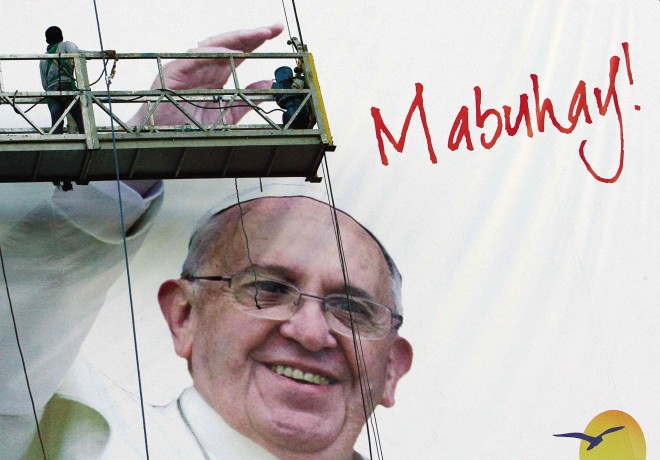‘Reduce waste, reuse tarpaulins welcoming Pope’

THIS suggestion from Ecowaste would certainly get a thumbs-up from Pope Francis: Recycle the tarpaulins welcoming him and turn these into useful items like bags, mats and roofing material for temporary shelters. Raffy Lerma
Time to heed Pope Francis’ call for people to care for the environment, starting with the tarpaulins used to welcome him.
An environmental group suggested on Wednesday that “Welcome, Pope Francis” tarpaulins put up around Metro Manila be recycled rather than be added to the mountain of trash left behind by people who attended the Pope’s engagements or waited for him in areas included in the papal convoy’s route.
Earlier, the Metropolitan Manila Development Authority said that it collected 138 tons or 23 truckloads of garbage during the four-day papal visit, while the Manila City government picked up 1,133 tons of trash from areas that the Pope went to, including Rizal Park where he celebrated Mass for a record 6 million people, the largest crowd for a papal gathering.
According to EcoWaste Coalition, on top of adding to the garbage generated by the Pope’s visit, the vinyl-based tarpaulins would also release toxic pollutants if burned or dumped haphazardly.
The group said there were many ways to reuse tarpaulins for nonfood and nonchild uses, depending on their make, design and size.
“Avoiding the haphazard disposal of used tarps will cut the volume of waste being disposed of, as well as curb the environmental pollution from their dumping or burning, knowing that tarps are mainly vinyl-based containing toxic chemicals,” Ecowaste Coalition campaigner Tin Vergara said.
“We can keep these tarps out of dumps, landfills, cement kilns and incinerators by giving them a new lease of life through appropriate recycling,” she added.
Vergara said the large tarpaulins displayed on the facade of buildings and fences may be reused as protective cover sheets for a variety of things such as vehicles, carriages for religious icons, wooden pushcarts or “kariton” and anything that needs protection from dust, dirt, the sun and rain.
According to her, even homeless people have been using discarded tarps as a cover, blanket or mat.
She said the more sturdy ones could be used as a roofing material in makeshift shelters for disaster evacuees.
On the other hand, the smaller tarpaulins such as those hung on electric posts could be sewn into carry bags, storage sacks, shoe racks, paint drop clothes, utility aprons and multipurpose holders, she added.
Vergara said that pedicab, jeepney and tricycle drivers may also use the tarpaulins to protect their vehicles from the sun and rain.
However, she stressed that the production, use and disposal of tarpaulins should eventually be regulated to address the chemical, health and environmental concerns they pose.














